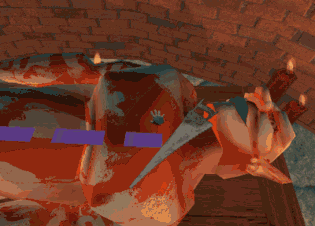
Featured Blog | This community-written post highlights the best of what the game industry has to offer. Read more like it on the Game Developer Blogs.
It's what's inside that matters: on the generation of procedural organs
For my PROCJAM entry this year, I did a demon dissection game and yes, it's as weird as it sounds. It's one of the prototypes for my current project, Bestiarium. In this post, I discuss some rather mundane techniques required for doing such a weird game.

This post was originally posted on my personal blog. Excuse all the Twitter embeds, they were just the best way to post the MP4s in here :)
Things are getting a bit more ORGANIZED.GET IT!? Because ORGANS! HAH!
— Yanko Oliveira (@yankooliveira) November 10, 2016
I'll show myself out.#procjam #gamedev #indiedev #sleepdeprivation pic.twitter.com/qkfyWI46lr
When I enter game jams, I go full crunch mode, which usually ends up in very awkward sleep-deprived Mondays at work. The older I get, the harder it is for me to get hyped enough to do one. Fortunately, PROCJAM is super chill, which makes it perfect for me. Also because cheating is totally okay, which means I can do stuff like necroing my organ generator that I worked on for Bestiarium a few months ago and actually building a prototype around it.
Even though I went through a long time without touching it, Bestiarium has an impressive amount of ideas floating around in my head, but there are a few "philosophical" points where it stands upon. It was always supposed to be a "one room roguelike", so inevitably the exploration space will be less towards the "outside" and more towards the "inside", which makes that William Blake poem fit like a glove:
To see a World in a Grain of Sand
And a Heaven in a Wild Flower,
Hold Infinity in the palm of your hand
And Eternity in an hour.
This sort of thing, to me, ends up being more fun when it's taken on a literal direction. So I guess it's more towards the "insides".

One of the main mechanics of the game would involve extracting materials from the creatures you can summon. I could do the regular thing and just drop "rabit's foot" and "spider eyeball" from them but it's also a game about science, and how science sometimes about trial and error (and most of the times, hard work and elbow grease).
So here was the pitch of a small bullet point marked with "probably wouldn't work" on my design notes: you have to dissect the creatures to harvest elements from them. PROCJAM was obviously a perfect excuse for actually wrapping a prototype around that and test out.
De daemonici corporis fabrica (which is verbatim the demonic version of De humani corporis fabrica) tries to emulate what ancient scholars could have felt when they opened up a corpse for the first time, which was probably some variation of "what the hell is this lumpy, wrinkly thing for exactly?". But I digress. This post is about the tech side, and it all started with... well, how the hell can we generate procedural organs?
It all started many months ago with a night filled with watching animal dissection videos (most research work for this thing reminded me of this Gamasutra article). I could of course just go towards morph targets in a bunch of pre-made organ models. But I had just added a Markov Chain-based name generator to the Invocation Prototype, and that got me thinking: could I maybe use it to generate organs that are more similar to "real" ones?
For markov chains, we need some starting samples:
![]()
Yes, incredible 8x8 pixel templates that kind of resemble organs if you squint your eyes. The first thing I did was simply encoding black and white into 0s and 1s in a string, then feeding that into the Markov chain - something that I was pretty sure wouldn't work, but I wanted to try a step by step approach.
| Guess what? Yeah, I was right, it just generated glitchy-looking textures, because images require 2-dimensional consistency. So the next step was encoding the image in a group of integer 2d positions for all the white pixels. That actually generated some interesting results that were plausible variations of the input. |
MOAR, I thought, increasing the samples to 16x16. Turns out 8x8 is the sweet spot, and I didn't look much into ways of improving the resolution (or if it makes sense to do so). Ok, we've got some organ-y shapes, but they're lo-res and 2d. How to take this up a dimension? The first thing that comes to mind was using some form of metaballs. |
|
| I ended up simply translating the image into a 8x8x1 3d grid directly and feeding it to a marching cubes algorithm. 3d achieved, but very blocky. Following my usual greedy approach to prototypes and game jams, instead of doubling back and getting metaballs to work, I decided to do some mesh smoothing algorithm on top of the generated mesh. |
I simply threw in this mesh filter from the Unity Wiki, and it improved the shapes quite a bit. However, the organs were still totally flat. I simply added some random offset in the Y direction for all the vertices that were in flat faces (i.e: had the normals pointing straight up or down). Well would you look at that. Granted, it is mostly pareidolia, but I can totally see a spleen, a lung, a liver... a spleen... and... well, you know, organ-like shapes. |
|
Then the time came to texturing, and I again tried to cut corners running away from unwrapping the UV on this thing. I did a bunch of experiments using 3d noise functions (you can get the noise shaders I ported from this repo in a handy, barely tested CGINC for Unity). They looked pretty cool (and I'll probably use it somehow), but the cheap solution got really expensive when I had to generate normal maps out of it.
Playing around combining noise functions is way more fun than I expected. Now I get @3dju's Substances addiction! pic.twitter.com/wwHI87k8Tu
— Yanko Oliveira (@yankooliveira) June 19, 2016
In the end, just a simple planar UV map (by plotting XZ vertex position normalized into UV space) was good enough, and I could use painted textures (which not only got me grossed out getting photo sources, but also RT'd by Polycount).
"What are you up to this saturday night?"
— Yanko Oliveira (@yankooliveira) November 5, 2016
"Oh, you know, the usual, doing seamless viscera textures and stuff"#screenshotsaturday #gamedev pic.twitter.com/4ZktlppojH
Yay, sausages!
| Ok, so we have the organs generated. But now we have to fit them into that good ole imp. The open chest was relatively easy: I just had to create an extra morph target on the imp model. But what about the organ positioning? Originally I though that I'd have to create a very complex bounding algorithm to make sure everything "packed" together properly. In the end, just having spawn points attached to the bones of the creature was enough. But there's still a problem: they're clipping out of the body, as seen on the red circle areas. |
Stencil buffer to the rescue! We can use the stencil buffer to "mask" a region of the chest, and only render organs in that area. The mask mesh (shown in green) is perfectly flat, and you can spot the borders if you pay a lot of attention. But even moving, the overall effect is good enough. |
|
Looking back, most of my solutions were maybe overkill and I could probably achieve a better result with a good artist handcrafting all those organs, but it was a fun experiment. In the end, I guess it was mostly about exploring this uncharted territory which, weird as it might be, I'm pretty sure wasn't visited before.
You can play De daemonici corporis fabrica on my itch.io page while I cook up the Vive version, and follow me @yankooliveira to see what I'm up to with Bestiarium.
Read more about:
Featured BlogsAbout the Author(s)
You May Also Like















